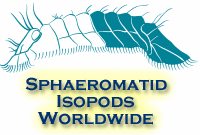| Abstract |
Many crustacean species live symbiotically on, in, or with other marine
macroinvertebrates. Characteristics of the macroinvertebrate hosts will have strong
effects on the ability of crustaceans in defending host individuals and movements
between hosts. Herein we developed a predictive model in order to examine how the
"symbiotic environment" affects the social behaviour of symbiotic crustaceans. We
considered two key vectors affecting the social behaviour of symbiotic crustaceans:
A) their host monopolisation potential, and B) their intraspecific encounter rates.
The monopolisation potential depended primarily on proximate factors such as the
relationship between symbiont size and host size, host morphology, and weaponry
of the symbiont species. The larger the symbiotic crustacean in relation to its host the
higher is its potential to monopolise its host: relatively large symbiont species
monopolised one host individual as solitary individuals or as heterosexual pairs
while small species tended to share a host individual with many conspecifics. The
tendency of symbionts to move between individual hosts was primarily affected by
proximate factors such as predation pressure and host distribution and abundance. |

















